
Many people have no idea what a Blockchain is, much less how to implement one in their own applications. Fortunately, there are two distinct types of Blockchains: An open source one, and one that is based on a closed source technology – i.e. cryptosystems – which many in the finance industry are gravitating towards. These are not the same things though, so read on for the definitions and then some. In this article we will define what exactly is a Blockchain, what it does, and how we can use one of these to improve our finance industry and in the process make ourselves a better company (and therefore a better investor).

A full-fledged Blockchain is nothing more than a Distributed Ledger Technology (DLT) where every participant in the network acts as a “counterparty” to the entire chain of transactions that occurs within the ledger. Basically you could think of a Blockchain like an obsessed fanclub full of diehard fans who share all the information they experience in order to make their heads spin in excitement at the world-wide-impact of everything that happens. In the case of the bitcoin blockchain, every transaction is protected by a digital signature which guarantees that nobody can alter the underlying code in any way without the permission of the owner of the wallet. This is similar to what a bank would do with their financial instruments, and it is also how the government of different countries are moving towards creating the same infrastructure for their financial systems that would protect their national currencies from outside influences. You can think of the bitcoin blockchain as a worldwide, central computer system where all the different transactions take place that ensures that the entire system stays secure and working the way that it was meant to run.
One of the reasons why you would want to use a safe and secure solution to transfer money online, rather than transferring it over the counter, is because of the high level of security that the bitcoin protocol provides. This is because it uses proof-of-work based blockchains which are considered to be much more secure than other alternative forms of blockchains. Proof-of-work, or proof-of-stake, is a system where a specific number of computers is required to compute and verify the validity of the transactions of a certain number of users before they are accepted. This is what makes it secure because there is no way for anyone to cheat or manipulate the system because all transactions are based on the rules of the entire network.
Another reason why many people are investing in this technology today is because of the incredibly low startup costs, which is quite unheard of when you compare the costs of more established protocols such as Visa and Mastercard. One of the best aspects of the new virtual currency revolution is that there are many different altcoins that you can invest in. With the new wave of blockchains out there, you can invest in coins such as Peercoin and DoCoim, which are both very low cost and easy to use. In addition to this, many more cryptosystems are being developed and launched each day, meaning that investing in the future is never-ending.
The main function of the ledger is to act as the central information database of the system. The ledger works much like a virtual computer where all transactions are recorded in an encrypted form so that even if someone steals your computer and tries to go through the transaction, they will not be able to read any of the information. The reason why the blocks are secured is that the ledger itself is constantly being updated. The only time a transaction is not secure is when a miner with malicious intent decided to flood an area with transactions and ruin the value of that particular area’s ledger. This is what is known as a ” miner attack” and it is a problem that has been solved by the technology.
Another reason why investing in the future of this revolutionary technology is smart is because the blocks are decentralized and there is no centralization or ISP which adds extra overhead for users. With decentralization comes security and the proof of this is that the chains have seen nearly a 500% increase in transaction volume on a regular basis, something that was previously impossible. Also, if you are trying to decide whether an investment in the future of the internet is right for you, then you should definitely consider the decentralized nature of the chain. It is the future of the internet, and it has never been seen better.
